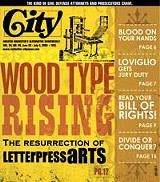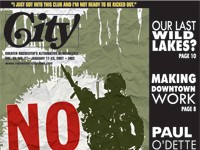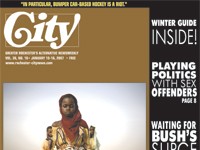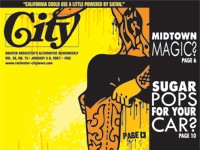[
{
"name": "500x250 Ad",
"insertPoint": "5",
"component": "15667920",
"parentWrapperClass": "",
"requiredCountToDisplay": "1"
}
]
Beneath the computer-dominated world of contemporary graphic design lies an underground subculture dedicated to an ancient, organic method of printing. This cult is composed of an unusual gang of typophiles, paper snobs, luddites, wood carvers, and poets. Presses like Yee-Haw, Boxcar, Brightwork, and Silver Buckle are breathing new life into the letterpress arts --- a craft most people thought died about 50 years ago.
It's not just basement-dwelling fanatics who are attracted to the letterpress. The clientele ranges from popular magazines like Runner's World to museums like the Country Music Hall of Fame.
But the craft is so esoteric and so specialized, letterpress printers are situated firmly on graphic design's fringes. Equipment is no longer in production, and higher-learning programs are scarce. The few who carry on the tradition tend to write their own rules.
The good ones pick and choose projects and almost always work for themselves rather than mega-corporations. "I've been able to cherry-pick the real fun stuff," says Ross MacDonald of Connecticut's Brightwork Press. "I have a strict 'no wedding invitations' policy."
This freedom allows letterpress printers to do away with platitudes and niceties. And you'll often find lyricism and whimsy in unlikely places. "A crisp letterpress impression is, to us, like a blue-skied mountain summit covered with berries --- we love that," writes Debbie Urbanski on the website for Syracuse's Boxcar Press. Boxcar's online catalogue is filled with fresh language. Urbanski is a printer and writer, and is one of many poets attracted to the uncommon depth and unpredictability of the letterpress aesthetic.
Each print made with a printing press is unique, and the look cannot be imitated by a digital printer. With a letterpress, words and images are actually pressing into the paper, giving it a palpable texture you can sense with your eyes and feel with your fingertips.
For more than 500 years, there was one way --- and one way only --- to design and print for mass communication. Johannes Gutenberg invented the printing press in Germany in the 1430s, effectively creating a device capable of conveying information to vast numbers of people. Over the next couple centuries, this primitive approach --- called letterpress --- became the predominate means of printing. What was originally a crude method bloomed into a specialized art, fueled by a set of highly skilled and dedicated craftsmen.
Then came off-set printing in the 1950s, and within 10 years there was a complete paradigm shift. Letterpress printing had become obsolete. The skills of craftsmen were no longer in demand, and their tools --- engravings (the equivalent of clip-art and fonts), ink rollers, and gigantic printing machines --- were of even less value. In its wake, the industry left behind the freight of 500 years of printing.
This is the point where things became exciting. Since letterpress was no longer a commercially viable process, the equipment slipped through the fingers of big business and into the hands of artisans, craftsmen, and poets. Much from this era had been lost or melted down into scrap metal, but while the majority of the industry was busy gathering scanners and laser printers, a set of gleaners was plundering the wreckage.
In the mid '90s, former printer turned illustrator Ross MacDonald found himself printing small jobs in New York City on a portable press and sending large jobs elsewhere. "I thought, 'What am I doing hiring printers? I'm a printer myself. I can do a half-ass job for free.'"
MacDonald sought out type and presses in the small, rust-belt towns of America. "When I first started tracking this stuff down, the internet was not the place where you did the legwork," he says. "There was a lot of detective work involved... The more you find out, the more you want to know." He also encountered slight resistance. "People thought you were freakin' morons for wanting to hand-set type."
In his sleuthing MacDonald discovered Peru, Indiana, a small old circus town where migratory carnival workers would hole up during off-seasons. Tucked away in Peru was a classic print shop the circus folks would use to create promotional materials. It had been functional since the 1890s.
"The owner was getting old, the roof blew off the shop, he had all this rusty equipment," MacDonald says. "It's a tough way to make a living." The owner offered to sell MacDonald the entire collection at wholesale. He even sent MacDonald low-grade Xerox copies of all the "A" letters from each of the types.
Reluctant to re-enter his former profession, he bought type in small batches. But those small batches accumulated. "By the time I'd paid half the price on it, I said 'Fuck it, just send the whole bunch.'"
"Now there's eBay, where you can buy type and presses. But it goes for really high prices," MacDonald says. "Interest has spiked."
"Ten years ago it was pennies on the dollar," says Julie Belcher, co-founder of Yee-Haw Industrial Letterpress and Design in Knoxville, Tennessee. "Now letterpress is getting more and more expensive. However many there were, that's what's out there... When we started, we didn't know if the equipment even existed anymore."
Over at the Rochester Institute of Technology's Cary Graphic Arts Collection, Curator David Pankow tells a similar tale.
"I knew that at some point RIT was going to be giving up all its letterpress equipment," he says. "At that time, there was still a letterpress lab in the school of printing, but I knew that if trends were continuing as they surely were --- away further and further from letterpress as a commercial process --- that if this facility didn't save it then, it wasn't going to get saved. I took from that lab whatever I thought would be useful for us." Other schools discarded their equipment and never looked back. Prince Street's Visual Studies Workshop, which once had a fully operating print shop, no longer teaches or practices the craft.
Creating print on letterpress is no walk in the park, unless that walk is tethered by a lead ball and chain. Printer Ben Whitla, formerly of Syracuse's Boxcar Press, once justified a pre-noon drink by pointing to his craft. He claimed that printers, in their halcyon days, had the highest rate of alcoholism of any profession. He told a story about an old-school printer who, on a job with a particularly tight "registration" (the tedious alignment of two or more colors), would hang a handle of vodka from his press in the morning. By the end of the day, the bottle would be nearly empty.
"There's plenty of times I'm here at three in the morning with tears rolling down my face," MacDonald says.
Each letterpress print shop works with a slightly different recipe. One of the most traditional is that of Yee-Haw, according to its website. "We start out by sketching our ideas on paper. This is the first testing ground for designs and illustrations, as well as original typography. It's in the sketching process that we determine how many colors a poster will require." The sketching stage is one of the most important, because this is the only opportunity you have to experiment, to revise and calibrate the layout. The "undo" command does not exist in the language of letterpress.
"Selecting and laying out any lead type, wood type, typography, or dingbats is done during the proofing stage," states the Yee-Haw website. "This is a painstaking process, often involving tweezers (for the tiny lead type letters) and lots of 'furniture'." "Furniture" refers to the physical blocks, made of metal or wood, that create leading, kerning, and spacing. On a computer, it's called a spacebar.
To spell out your text, you have to select the individual letters from their cases. Type has its own unique classification system, designed to be retrieved with maximum efficiency, like the arrangement of letters on a keyboard. But this system is so obsolete most people don't realize it exists, let alone know how to use it. When the type is found, you proceed to spell out the words, letter by letter. The catch: All type must be laid in backwards, from the right side of the page.
The final step is to ink the engravings and stamp the impression with the press. The actual inking process differs depending on the press, but essentially, you are coating the engravings with a rolling-pin apparatus that has been covered in printers' ink. Pressure is then applied to the paper so ink is transferred to the page.
The signature look of letterpress printing is a slight embossing effect that can be felt in subtle relief under your fingers. In the old days, the most admired impression was the one that was the richest and the lightest, called "the printer's kiss." Now, in order to differentiate from alternative printing styles, printers often bite into the paper, creating a deeper and more tangible impression.
In the traditional mode of letterpress, your ability to create the desired effects depends entirely on the tools you have. The most successful printers are usually the ones who have the most varied collection of type and picture engravings. Any good graphic designer is going to have hundreds of typefaces and clipart at their disposal, all of which can be downloaded from websites. Letterpress printers must scrap their designs together with what they have lying around their workshop. If they need a particular font that's not in their shop, they have to get it custom engraved. But as RIT's Pankow points out, downloading would be far easier.
"There are very few foundries that are even making metal type any more, and those that do charge upwards of $30 a pound for it," he says. "If I pulled a case of type, you'd see that it might weigh 50 to 60 pounds. And that's just one size of one type-face design. That's a lot of money to invest in something that you can only use for a very specific purpose --- 36 point Palatino, for example, you can't use for very many things."
Not only does it have a limited use, but a wide variety of type occupies an unruly amount of space. The local Ermine Press in Webster (872-5558) has its operations set up in the expansive ground floor of an old barn. But there still seems to be little room to move around. Cabinets are covered in woodcuts of bees, ice cream cones, and bowlings ads. Buckets are filled with half-tone pictures of forgotten politicians. Long, skinny drawers of vintage type take up the rest of the floor space. Owner Michael Kopicki has been collecting since the '70s and seems to have an innate sense of where things are located. The rest of us, however, would be lost in the funhouse.
Type may be one of the more cumbersome components of letterpress, but it is also one of the most attractive. "What kind of man would spend his last dime on a heap of moldering obsolete printing equipment while his children run about in burlap smocks?" MacDonald writes on his website. "The kind who never met a font of 19th-century type he didn't like, that's who!"
"I love real workhorse 19th century type," he says in our phone interview. "Hard-use, real battered... I collect battered, funky, mundane types from the 1800s. To get that look on a computer is cheap."
The Cary Library is in the vanguard of preserving both metal and wood type, and it maintains one of the most important collections in North America. But with most of these types converted to a convenient digital format, why bother preserving it?
"They produce effects," Pankow says. "They produce a quality of printing that is not reproduced by any process available today. Letterpress, because of the three-dimensional quality of the image that you get when you press metal type into paper, it's unlike off-set printing; it's not like inkjet printing. So there are reasons to save it beyond simply a historic interest in preserving a particular process. There are aesthetic reasons for wanting to pass on the knowledge and history of letterpress printing."
In spite of the headaches that come with letterpress printing, when all the elements combine --- the rich colorful ink, the mould-made deckle-edged Italian paper, the super crisp impressions --- the visual results are harmonious. The bibliophile and collector Decherd Turner once coined this crystallization a "verbal theater," where "the viewers reading becomes performance." He followed that by saying, "Who knows what a century of computer ugliness will do to the form of letters."
How does today's audience react to letterpress? Some enthusiasts, like Jim Malley of Mercury Posters (1 Sumner Park, 271-3110), seeks it out for his store. "I just like having it around," he says. "I don't care if people buy it or not." He also contracts with Yee-Haw to have business cards and posters made. "It gives you something a little more substantial. It's good to drop by someone's house and see they still have your card on their fridge."
Despite appearances, digital technologies are actually revivifying letterpress arts. With a set number of vintage resources, it's nearly impossible to get into letterpress from scratch. But a hybrid of computer technology and traditional letterpress, called "photopolymer engraving," is creating a fresh palette available to printers.
"A lot of letterpress programs [in universities] are very excited about the advances made in photopolymer plate printing," Pankow says. "That allows you to do all your composition on the computer. It allows you to output those files to film, and that film is used to expose photopolymer plates which you can put on any conventional letterpress machine and get an effect that I think almost everybody would be unable to distinguish from metal type."
Still, despite its limitations, some printers are sticking with the traditional methods. The few who still practice say there's a certain discipline and authenticity that cannot be faked. Akin to vinyl enthusiasts and celluloid-dedicated cinephiles, they perceive this form to be superior.
"I never use photopolymer," MacDonald says. "To me, I just don't enjoy it. I made the analogy once: If you love beautiful wooden sailboats, would you buy a fiberglass sailboat and then paint it with a faux wood grain?"
"There are purists of letterpress who say there is something about that commitment that you make to a text," Pankow says. "You select a text very carefully, and then you say, 'I am going to commit the time that it takes to set the type individually, letter by letter, to get this text into metal so I can print it.' It gives those printers a greater sense of intimacy, I suppose, a sense of devotion to the craft. I think they feel it brings them closer to what the ideals of letterpress printing are all about."
Letterpress on the web
To learn more about letterpress printing, start at the Briar Press, a wellspring of knowledge for the novice. It contains a glossary of terms, a classified section for used equipment, and an outline of historically important presses. It also has a comprehensive directory of more than 500 businesses related to the letterpress industry. www.briarpress.org/briarpress
The site for Five Roses Press has guides to higher-education letterpress programs, internet mailing lists, printing museums, and a handy step-by-step essay for amateurs looking to start from scratch. www.fiveroses.org
The Cary Collection at RIT is a graphic design library and working print shop which doubles as a museum of classic presses that is open to the public. If you want to see artifacts first-hand, pay a visit. For browsing purposes, the Cary website has examples of printing that date back to the earliest days of Gutenberg as well as a selection from its collection of presses. wally.rit.edu/cary
The following printers are discussed in the article, and are examples of some of the best, most creative printers working in the letterpress field.
• Brightwork Press; Ross MacDonald; ross-macdonald.com/index.html
• Yee-Haw Industrial Letterpress and Design; Knoxville, Tennessee; yeehawindustries.com
• Boxcar Press; Syracuse; www.boxcarpress.com/index.html
If you're interested in seeing more work by letterpress printers, the following sites are small indie presses with posted galleries.
• Hot Iron Press; New Orleans, Louisiana; www.hotironpress.com/index.htm
• Cockeyed Press; Chapel Hill, North Carolina; www.cockeyedpress.com
• Cannonball Press; New York City; www.cannonballpress.com
Even though the web is a great resource, a lot of information passes under the internet radar. Many supplies are available just by asking the old folks in your town. Also, certain printers have yet to enter the digital age. The Third Termite Press in Pittsburgh is one of the best and most traditional letterpress printers in the industry, but it has yet to establish a website. In order to see Third Termite's work, you have to stop by the shop.
Latest in Featured story
More by Michael Neault
-
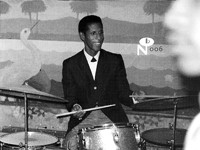
The Numero Group
Dec 27, 2006 -
Bollywood lights
Jun 28, 2006 -

Hard day on the planet
Jan 11, 2006 - More »
